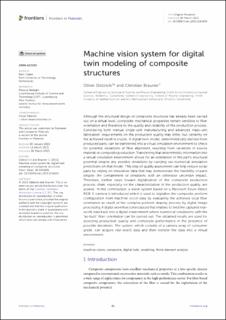Please use this identifier to cite or link to this item:
https://doi.org/10.21256/zhaw-27695Full metadata record
| DC Field | Value | Language |
|---|---|---|
| dc.contributor.author | Döbrich, Oliver | - |
| dc.contributor.author | Brauner, Christian | - |
| dc.date.accessioned | 2023-04-21T08:59:18Z | - |
| dc.date.available | 2023-04-21T08:59:18Z | - |
| dc.date.issued | 2023-03-30 | - |
| dc.identifier.issn | 2296-8016 | de_CH |
| dc.identifier.uri | https://digitalcollection.zhaw.ch/handle/11475/27695 | - |
| dc.description.abstract | Whereas the structural design of composite structures is already carried out on a virtual level, composites mechanical properties remain sensitive to the fiber orientation and therefore to the quality and reliability of the production process. Considering both, manual single-unit manufacturing and advanced mass-unit fabrication, requirements on the production quality may differ but certainty on the achieved result is crucial. A digital twin model, deterministically derived from produced parts, can be transferred into a virtual simulation environment to check for potential deviations of fiber alignment resulting from variations in source material or production of the composite. Transferring that deterministic information into a virtual simulation environment allows for an estimation of the part’s structural potential despite any possible deviations by carrying out numerical simulation predictions on that model. This step of quality assessment can help to reduce scrap parts by relying on simulation data that may prove a feasibility of parts despite the containment of deviations with an otherwise uncertain impact. Therefore, further steps towards a digitalization of the composite production process chain, especially on the characterization of the production quality, are aspired. In this contribution a vision system based on Microsoft’s Azure Kinect RGB D camera is introduced which is used to digitalize the composites preform configuration from machine vision data by evaluating the achieved local fiber orientation as result of the complex preform draping process by digital image processing. A digital workflow is introduced that enables to feed the captured real-world data back into a digital environment where numerical simulations with the “as-built” fiber orientation can be carried out. The obtained results are used for an assessment of production quality and composite performance in presence of possible deviations. The system which is composed of a camera array from consumer hardware is able obtain real world data, which it then makes available in a virtual environment. | de_CH |
| dc.language.iso | en | de_CH |
| dc.publisher | Frontiers Research Foundation | de_CH |
| dc.relation.ispartof | Frontiers in Materials | de_CH |
| dc.rights | https://creativecommons.org/licenses/by/4.0/ | de_CH |
| dc.subject | Machine vision | de_CH |
| dc.subject | Composites | de_CH |
| dc.subject | Digital twin | de_CH |
| dc.subject | Finite element analysis | de_CH |
| dc.subject | Modeling | de_CH |
| dc.subject | Faserverbundstoff | de_CH |
| dc.subject | Digitalisierung | de_CH |
| dc.subject.ddc | 003: Systeme | de_CH |
| dc.subject.ddc | 620.11: Werkstoffe | de_CH |
| dc.title | Machine vision system for digital twin modeling of composite structures | de_CH |
| dc.type | Beitrag in wissenschaftlicher Zeitschrift | de_CH |
| dcterms.type | Text | de_CH |
| zhaw.departement | School of Engineering | de_CH |
| zhaw.organisationalunit | Institute of Materials and Process Engineering (IMPE) | de_CH |
| dc.identifier.doi | 10.3389/fmats.2023.1154655 | de_CH |
| dc.identifier.doi | 10.21256/zhaw-27695 | - |
| zhaw.funding.eu | No | de_CH |
| zhaw.originated.zhaw | Yes | de_CH |
| zhaw.publication.status | publishedVersion | de_CH |
| zhaw.volume | 10 | de_CH |
| zhaw.publication.review | Peer review (Publikation) | de_CH |
| zhaw.webfeed | Faserverbundwerkstoffe | de_CH |
| zhaw.webfeed | Industrie 4.0 | de_CH |
| zhaw.webfeed | Prozesstechnik | de_CH |
| zhaw.author.additional | No | de_CH |
| zhaw.display.portrait | Yes | de_CH |
| zhaw.monitoring.costperiod | 2023 | de_CH |
| Appears in collections: | Publikationen School of Engineering | |
Files in This Item:
| File | Description | Size | Format | |
|---|---|---|---|---|
| 2023_Doebrich-Brauner_Machine-vision-system-for-digital-twin-modeling-of-composite-structures_fmats.pdf | 2.37 MB | Adobe PDF |  View/Open |
Show simple item record
Döbrich, O., & Brauner, C. (2023). Machine vision system for digital twin modeling of composite structures. Frontiers in Materials, 10. https://doi.org/10.3389/fmats.2023.1154655
Döbrich, O. and Brauner, C. (2023) ‘Machine vision system for digital twin modeling of composite structures’, Frontiers in Materials, 10. Available at: https://doi.org/10.3389/fmats.2023.1154655.
O. Döbrich and C. Brauner, “Machine vision system for digital twin modeling of composite structures,” Frontiers in Materials, vol. 10, Mar. 2023, doi: 10.3389/fmats.2023.1154655.
DÖBRICH, Oliver und Christian BRAUNER, 2023. Machine vision system for digital twin modeling of composite structures. Frontiers in Materials. 30 März 2023. Bd. 10. DOI 10.3389/fmats.2023.1154655
Döbrich, Oliver, and Christian Brauner. 2023. “Machine Vision System for Digital Twin Modeling of Composite Structures.” Frontiers in Materials 10 (March). https://doi.org/10.3389/fmats.2023.1154655.
Döbrich, Oliver, and Christian Brauner. “Machine Vision System for Digital Twin Modeling of Composite Structures.” Frontiers in Materials, vol. 10, Mar. 2023, https://doi.org/10.3389/fmats.2023.1154655.
Items in DSpace are protected by copyright, with all rights reserved, unless otherwise indicated.